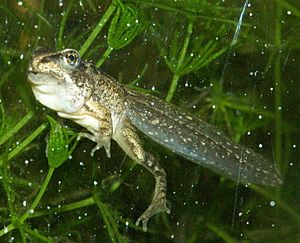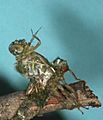Metamorphosis facts for kids
Metamorphosis in biology is a cool process where an animal changes its body shape and way of life as it grows from a young form to an adult. Think of it like a big transformation! The best examples are insects and amphibians. For most insects, life starts as a tiny larva or nymph, then it might go through a pupa stage, and finally, it becomes an adult.

Contents
Insect Life Cycles
Insects have two main ways they change as they grow:
- Simple metamorphosis (also called hemimetabolism)
- Complete metamorphosis (also called holometabolism)
Simple Metamorphosis: Growing Up in Stages
Insects that go through simple metamorphosis have three main life stages. They start as tiny eggs. When an egg hatches, a baby insect called a larva or nymph comes out.
Nymphs usually look a lot like the adult insect, but they are smaller and don't have wings yet. As the nymph grows, it sheds its outer skin, a process called molting. Each time it molts, it gets a bit bigger and looks more like an adult. These growth stages are called instars. Finally, after several molts, the nymph changes into a mature adult with wings.
Some insect nymphs live in water, like baby dragonflies. These are called naiads. They often have gills and can look quite different from the adults they will become.
Here are some insects that have a life cycle of egg, nymph, and then adult:
Complete Metamorphosis: A Big Transformation
Insects with complete metamorphosis have four distinct life stages. They also start as tiny eggs. When the egg hatches, a larva comes out. This larva often looks like a worm and spends its time eating and growing much bigger. Think of a caterpillar (which is a butterfly larva)!
Once the larva has grown enough, it changes into a pupa. The pupa usually can't move or eat. This is a special time when the insect is completely changing its body inside a protective case. For example, Moth pupae are often found inside cocoons. When the pupa stage is over, the adult insect comes out, looking very different from the larva or pupa.
Many insects have a life cycle of egg, larva, pupa, and then adult. Some examples include:
- The amazing journey of a cabbage white butterfly, showing complete metamorphosis.
-
The larva (caterpillar) stage.
-
The pupa stage, also called a chrysalis for butterflies.
-
The beautiful adult butterfly emerges!
The Monarch Butterfly's Life Cycle
The monarch butterfly is a great example of complete metamorphosis. Its life begins as a tiny egg laid by an adult butterfly. This egg then hatches into a worm-like larva, which we call a caterpillar.
The caterpillar eats a lot, mostly milkweed leaves, to grow big. Then, it enters the pupa stage, also known as a chrysalis. The caterpillar hangs upside down from a twig or leaf and sheds its skin, revealing a green, hard outer shell. Inside this chrysalis, the caterpillar's body completely changes. After about two weeks, the mature butterfly emerges from the chrysalis. The adult butterfly then feeds on nectar from various flowers, like milkweed flowers and goldenrod.
Amphibian Metamorphosis

Most amphibians, like frogs, toads, and newts, lay their eggs in water. When the eggs hatch, they become larvae that are perfectly suited for living in water.
Frog and toad larvae are called tadpoles. They usually have external gills to breathe underwater and scrape food off surfaces. Newt larvae also have external gills but often start hunting small creatures. As they grow, these larvae slowly change, losing their gills and developing lungs and legs, until they can live on land as adults.
Why Animals Metamorphose
Metamorphosis is super important, especially when you think about how different a baby animal is from its adult form. For example, a huge Atlantic cod fish can be two meters long and weigh over 90 kilograms! But the female cod lays over 100,000 tiny eggs. The larvae that hatch from these eggs are incredibly small.
These tiny larvae can't live like the adult cod, which are powerful predators. The larvae can't even swim against strong currents. So, they have to live a completely different kind of life until they are big and strong enough to live like the adults.
Metamorphosis helps animals develop in stages. Each stage has special features that help the animal survive at that particular time in its life. The clear changes between stages, especially in insects, probably help the young animal be super good at living its "kid life" before it transforms into its "adult life."
Images for kids
-
An almost ready common frog with some parts of its gill sac still visible and a jaw that's not fully grown.
See also
 In Spanish: Metamorfosis (biología) para niños
In Spanish: Metamorfosis (biología) para niños











